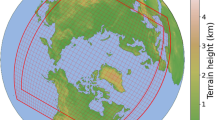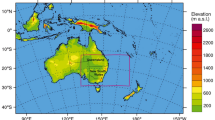Abstract
A series of model experiments with the coupled Max-Planck-Institute ECHAM5/OM climate model have been investigated and compared with microwave measurements from the Microwave Sounding Unit (MSU) and re-analysis data for the period 1979–2008. The evaluation is carried out by computing the Temperature in the Lower Troposphere (TLT) and Temperature in the Middle Troposphere (TMT) using the MSU weights from both University of Alabama (UAH) and Remote Sensing Systems (RSS) and restricting the study to primarily the tropical oceans. When forced by analysed sea surface temperature the model reproduces accurately the time-evolution of the mean outgoing tropospheric microwave radiation especially over tropical oceans but with a minor bias towards higher temperatures in the upper troposphere. The latest reanalyses data from the 25 year Japanese re-analysis (JRA25) and European Center for Medium Range Weather Forecasts Interim Reanalysis are in very close agreement with the time-evolution of the MSU data with a correlation of 0.98 and 0.96, respectively. The re-analysis trends are similar to the trends obtained from UAH but smaller than the trends from RSS. Comparison of TLT, computed from observations from UAH and RSS, with Sea Surface Temperature indicates that RSS has a warm bias after 1993. In order to identify the significance of the tropospheric linear temperature trends we determined the natural variability of 30-year trends from a 500 year control integration of the coupled ECHAM5 model. The model exhibits natural unforced variations of the 30 year tropospheric trend that vary within ±0.2 K/decade for the tropical oceans. This general result is supported by similar results from the Geophysical Fluid Dynamics Laboratory (GFDL) coupled climate model. Present MSU observations from UAH for the period 1979–2008 are well within this range but RSS is close to the upper positive limit of this variability. We have also compared the trend of the vertical lapse rate over the tropical oceans assuming that the difference between TLT and TMT is an approximate measure of the lapse rate. The TLT–TMT trend is larger in both the measurements and in the JRA25 than in the model runs by 0.04–0.06 K/decade. Furthermore, a calculation of all 30 year TLT–TMT trends of the unforced 500-year integration vary between ±0.03 K/decade suggesting that the models have a minor systematic warm bias in the upper troposphere.







Similar content being viewed by others
References
Bengtsson L, Hagemann S, Hodges KI (2004a) Can climate trends be calculated from reanalysis data? JGR Atmos 109:D11111. doi:10.1029/2004JD004536
Bengtsson L, Hodges KI, Hagemann S (2004b) Sensitivity of large scale atmospheric analyses to humidity observations and its impact on the global water cycle and tropical and extratropical weather systems. Tellus 56A:202–217
Bengtsson L, Hodges KI, Roeckner E, Brokopf R (2006) On the natural variability of the pre-industrial European climate. Clim Dyn 27:743–760
Bengtsson L, Arkin P, Berrisford P, Bougeault P, Folland CK, Gordon C, Haines K, Hodges KI, Jones P, Kallberg P, Rayner N, Simmons AJ, Stammer D, Thorne PW, Uppala S, Vose RS (2007) The need for a dynamical climate reanalysis. Bull Am Meteorol Soc 88:495–501
Christy JR, Norris WB, Spencer RW, Hnilo JJ (2007) Tropospheric temperature change since 1979 from tropical radiosonde and satellite measurements. J Geophys Res Atmos 112:D06102. doi:10.1029/2005JD006881
Dee DP, Uppala S (2009) Variational bias correction of satellite radiance data in the ERA-Interim reanalysis. Q J R Meteorol Soc. doi:10.1002/qj.493
Douglass DH, Christy JR, Pearson BD, Singer SF (2007) A comparison of tropical temperature trends with model predictions. Int J Climatol 28:1693–1701
Gibson JK, Kallberg P, Uppala S, Hernandez A, Nomura A, Serrano E (1997) The ECMWF re-analysis (ERA) 1. ERA description. ECMWF reanalysis project report series 1, ECMWF, (Available from the European centre for Medium-range weather forecasts, reading, UK), pp 71
Guilyardi E, Wittenberg A, Fedorov A, Collins M, Wang C, Capotondi A, van Oldenborgh GJ (2009) Understanding El Niño in ocean–atmosphere general circulation models: progress and challenges. Bull Am Meteor Soc 90:325–340
Hegerl GC, Zwiers FW, Braconnot P, Gillett NP, Luo Y, Marengo Orsini JA, Nicholls N, Penner JE, Stott PA (2007) Understanding and attributing climate change. In: Solomon S, Qin D, Manning M, Chen Z, Marquis M, Averyt KB, Tignor M, Miller HL (eds) Climate change 2007: the physical science basis. Contribution of Working Group 1 to the Fourth assessment report of the Intergovernmental Panel on Climate Change. Cambridge University Press, Cambridge
Jungclaus JH, Keenlyside N, Botzet M, Haak H, Luo JJ, Latif M, Marotzke J, Mikolajewicz U, Roeckner E (2006) Ocean circulation and tropical variability in the coupled model ECHAM5/MPI-OM. J Clim 19:3952–3972
Kalnay E, Kanamitsu M, Kistler R, Collins W, Deaven D, Gandin L, Iredell M, Saha S, White G, Woollen J, Zhu Y, Leetmaa A, Reynolds R, Chelliah M, Ebisuzaki W, Higgins W, Janowiak J, Mo K, Ropelewski C, Wang J, Jenne R, Joseph D (1996) The NCEP/NCAR 40-year reanalysis project. Bull Am Meteor Soc 77:437–471
Karl TR, Hassol SJ, Miller CD, Murray WL (eds) (2006) Temperature trends in the lower atmosphere: steps for understanding and reconciling differences. A report by the US Climate Change Science Program and the Subcommittee on Global Change Research. National Oceanic and Atmospheric Administration, National Climatic Data Center, Asheville, NC; p 164
Lanzante JR, Peterson TC, Wentz FJ, Vinnikov KY (2006) What do observations indicate about the change of temperatures in the atmosphere and at the surface since the advent of measuring temperatures vertically? In: Karl TR, Hassol SJ, Miller CD, Murray WL (eds) Temperature trends in the lower atmosphere: steps for understanding and reconciling differences. A report by the US Climate Change Science Program and the Subcommittee on Global Change Research, Washington DC
Mears CA, Wentz FJ (2009) Construction of the remote sensing systems V3.2 atmospheric temperature records from the MSU and AMSU microwave sounders. J Atmos Oceanic Technol (in press)
Meehl GA, Covey C, Delworth T, Latif M, McAvaney B, Mitchell JFB, Stouffer RJ, Taylor KE (2007) The WCRP CMIP3 multi-model dataset: a new era in climate change research. Bull Am Meteorol Soc 88:1383–1394
Oldenborgh GJ, van Philip SY, Collins M (2005) El Niño in a changing climate: a multi-model study. Ocean Sci 1:81–95
Onogi K, Koide H, Sakamoto M, Kobayashi S, Tsutsui J, Hatsushika H, Matsumoto T, Yamazaki N, Kamahori H, Takahashi K, Kato K, Ose T, Kadokura S, Wada K (2005) JRA-25: Japanese 25 year reanalysis—progress and status. Quart J R Meteorol Soc 131:3259–3268
Onogi K, Tsutsui J, Koide H, Sakamoto M, Kobayashi S, Hatsushika H, Matsumoto T, Yamazaki N, Kamahori H, Takahashi K, Kadokura S, Wada K, Kato K, Oyama R, Ose T, Mannoji N, Taira R (2007) The JRA-25 reanalysis. J Meteor Soc Jpn 85:369–432
Randall RM, Hermann M (2008) Using limited time period trends as a means to determine attribution of discrepencies in microwave sounding unit derived tropospheric temperature time series. J Geophys Res 113. doi:10.1029/2007/JD008864
Rayner NA, Parker DE, Horton EB, Folland CK, Alexander LV, Rowell DP, Kent EC, Kaplan A (2003) Global analyses of sea surface temperature, sea ice, and night marine air temperature since the late nineteenth century. J Geophys Res 108(D14):4407. doi:10.1029/2002JD002670
Roeckner E, Brasseur GP, Giorgetta M, Jacob D, Jungclaus J, Reick C, Sillman J (2006) Climate projections for the 21st century. Max Planck Institute for Meteorology Internal Rep., 32 pp. Available online at http://www.mpimet.mpg.de/fileadmin/grafik/presse/ClimateProjections2006.pdf.
Sakamoto M, Christy JR (2009) The influences of TOVS radiance assimilation on temperature and moisture tendencies in JRA-25 and ERA-40. J Atmos Oc Tech 26:1435–1455
Santer BD, Thorne PW, Haimberger L, Taylor KE, Wigley TML, Lanzante JR, Solomon S, Free M, Gleckler PJ, Jones PD, Karl TR, Klein SA, Mears C, Nychka D, Schmidt GA, Sherwood SC, Wentz FJ (2008) Consistency of modelled and observed temperature trends in the tropical troposphere. Int J Climatol 28:1703–1722
Sherwood SC, Meyer CL, Allen RJ, Titchner HA (2008) Robust tropospheric warming revealed by iteratively homogenized radiosonde data. J Clim 21:5336–5352
Simmons A, Hollingsworth A (2002) Some aspects of the improvement in skill of numerical weather prediction. Quart J R Met Soc 128:647–677
Simmons AJ, Willett KM, Jones PD, Thorne PW, Dee DP (2009) Low-frequency variations in surface atmospheric humidity, temperature and precipitation: inferences from reanalyses and monthly gridded observational datasets. J Geophys Res. doi:10:1029/2009JD012511
Spencer RW, Christy JR (1990) Precise monitoring of global temperature trends from satellites. Science 247:1558–1562
Trenberth KE, Stepaniak DP, Hurrell JW (2001) Quality of reanalyses in the tropics. J Clim 14:1499–1510
Uppala SM, Kållberg PW, Simmons AJ, Andrae U, Da Costa Bechtold V, Fiorino M, Gibson JK, Haseler J, Hernandez A, Kelly GA, Li X, Onogi K, Saarinen S, Sokka N, Allan RP, Andersson E, Arpe K, Balmaseda MA, Beljaars ACM, Van De Berg L, Bidlot J, Bormann N, Caires S, Chevallier F, Dethof A, Dragosavac M, Fisher M, Fuentes M, Hagemann S, Hólm E, Hoskins BJ, Isaksen L, Janssen PAEM, Jenne R, Mcnally AP, Mahfouf J-F, Morcrette J-J, Rayner NA, Saunders RW, Simon P, Sterl A, Trenberth KE, Untch A, Vasiljevic D, Viterbo P, Woollen J (2005) The ERA-40 re-analysis. Quart J R Meterol Soc 131:2961–3012
Acknowledgments
The authors would like to thank both Dr. C. Mears and Dr. J. Christy for providing the MSU weights. The JRA25 data where produced from the JRA25 long-term reanalysis cooperative research project carried out by the Japan Meteorological Agency (JMA) and the Central Research Institute of Electric Power Industry (CRIEPI). The ERA-Interim reanalysis data was obtained from the ECMWF data server. We acknowledge the modeling groups, the Program for Climate Model Diagnosis and Intercomparison (PCMDI) and the WCRP’s Working Group on Coupled Modelling (WGCM) for their roles in making available the WCRP CMIP3 multi-model dataset. Support of this dataset is provided by the Office of Science, US Department of Energy. We also would like to thank one of the reviewers for constructive comments on the manuscript.
Author information
Authors and Affiliations
Corresponding author
Rights and permissions
About this article
Cite this article
Bengtsson, L., Hodges, K.I. On the evaluation of temperature trends in the tropical troposphere. Clim Dyn 36, 419–430 (2011). https://doi.org/10.1007/s00382-009-0680-y
Received:
Accepted:
Published:
Issue Date:
DOI: https://doi.org/10.1007/s00382-009-0680-y




